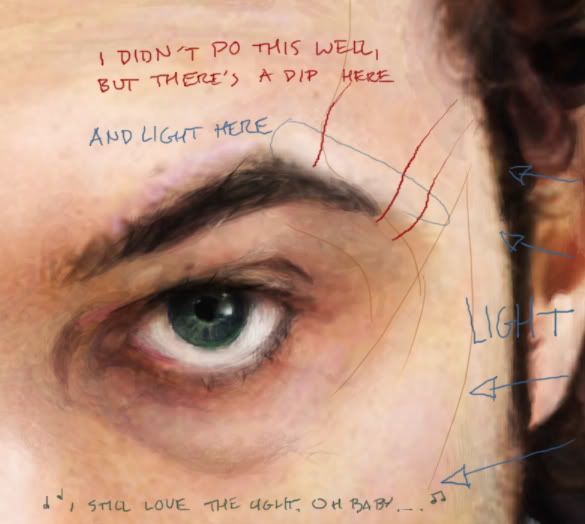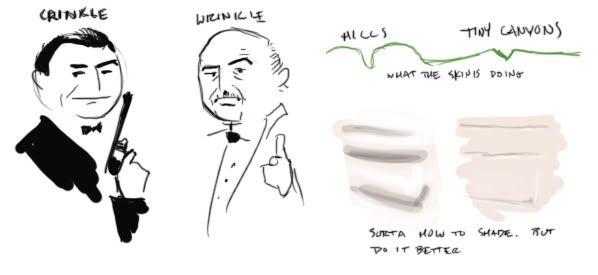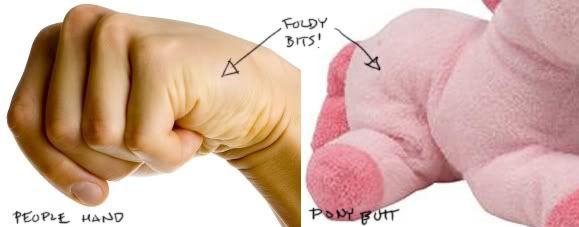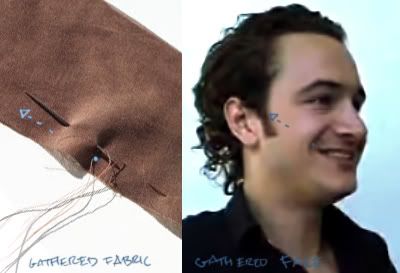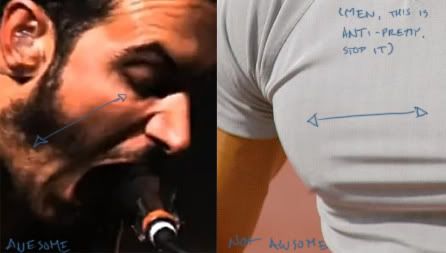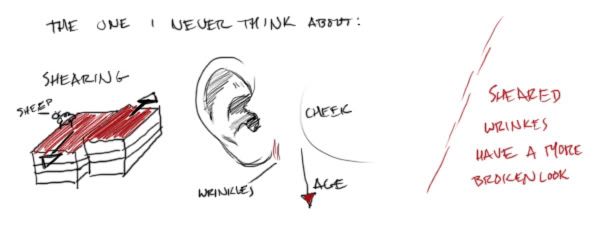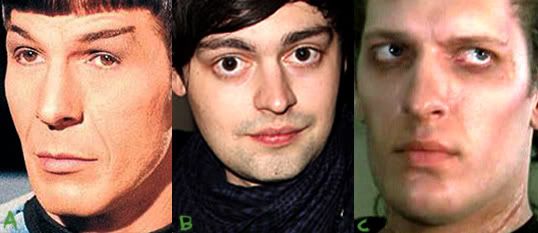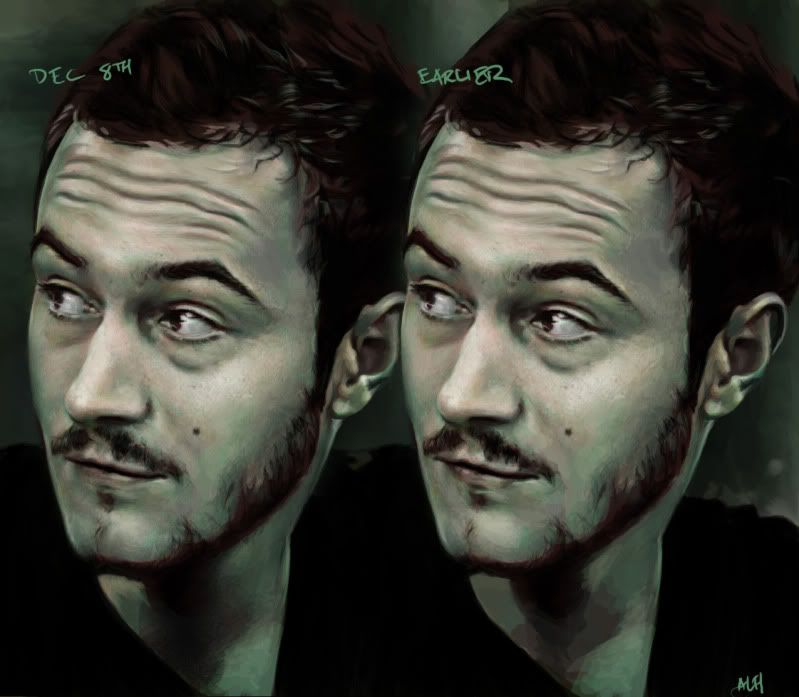
The pressure of trying to make sense is keeping me from posting. So instead of writing anything serious, here's what I've been working on. It's a strait forward project. Pulled a frame of Tom Smith from a youtube video and I just started painting it. Don't ask me why it's green. It's just what I was feeling.
There isn't usually two of him. The background's still boring and I wanted to show how much I did in five hours. The one on the left is the newer one. Also, photobucket killed some of my precious pixels.
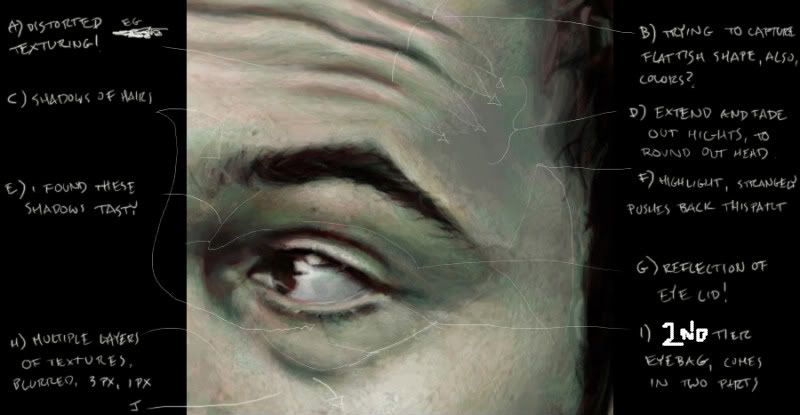
The biggest real change is (B) the shading of the crinkles on his forehead onto the temple. I did this to round out his head. Also because that's just the way it works. Forehead crinkles are just like small gathers in a stiff fabric.
On a smaller lever (A) the gathers work in a similar way. I've been noticing these small wrinkles. They're spidery and short. They're not deap enough to really show up in a youtube video shot, they take on more or less the same lightness as the surrounding plane of skin.
(C) It's difficult to draw hair. Because it's smaller than a pixel wide. Part of what I'm learning, is that letting parts of my strokes stay wide and transparent will actually imply a single hair, rising up. Also with hair, less is more. Except when it's not. Sometimes *coughMangacough* less is just less. And it looks like a spiky killer umbrella. Fucking stupid. Sorry, it's getting late. Also, sometimes there are weird shadows on a reference photo that I don't get and it turns out they're shadows of hairs that, for whatever reason, don't show up. Like stray eyebrow hairs and eyelashes. This is very confusing. But also a lot of fun.
(E) The upper-upper eyelid. Tom's got an interesting one. It's kind of taut and it makes a little bowl where the inner corner of his eye meets his nose. Research indicates that there is absolutely no good reason for this. Apparently, the fixed portion of the face only has a limited influence on where soft parts of the face connect. Sometimes, flesh just decides to do shit for lulz. This idea makes my eyes twitch. I want to beleive that if all this is connected, it's all got a reason for doing what it's doing.
Anywho! This area got all stretched out into a nice even arch by his expression, which made it rewarding and um... "tasty" to draw.
(F) I think I'm not alone in my "flat face" trouble. It's hard to make things look 3d. I have this old, bad habit. Some one once told me that using shadows was like pushing parts of the picture back into the page. This was very useful for a time... but it's really not now. The light is coming from stage left-ish here (stage left as in the actor's left, I'm a booth technician these days. So his left), so really, to make his cheek look like it was facing the left more, I had to make it brighter. Not darker. Notice how I colored in little elongated circles. I'm past the point of initial shading, so I use this time of fine tuning to detail, as well as fix planes. The trick is to pretend that you're painting on a 3d surface. Then it's only natural for your strokes to follow the shape of that surface.
(G) This discovery really deserves a post of it's own. I was so excited when I realized that this highlight was actually a foggy reflection of his upper eyelid in his upper-upper eyelid. I think I'll say more on that later.
(H) You can't see that well in this low-res picture, but there are three layers of texturing in there. At least. Probably more. The first is a blurry brush for big lumps in the skin. The second was a sharp, 3 pixel brush in a goldish pink. Those are the flatter portions of skin. Then there's a 1 pixel brush layer for pores and other small imperfections. On Tom, there's a fair amount of super tiny crinkling in this area. Which means a bit more 1 px work than other parts of the face. Skin doesn't have the same texture everywhere. We abuse it differently per piece of face.
(I) Tom is tired. He's got intense second tier eyebags today. Forgive the crappy photobucket edit. I labeled it wrong and I'm being lazy. They rest pretty much right over the orbit.
(J) This is an interesting shadow, that I need to talk about later.
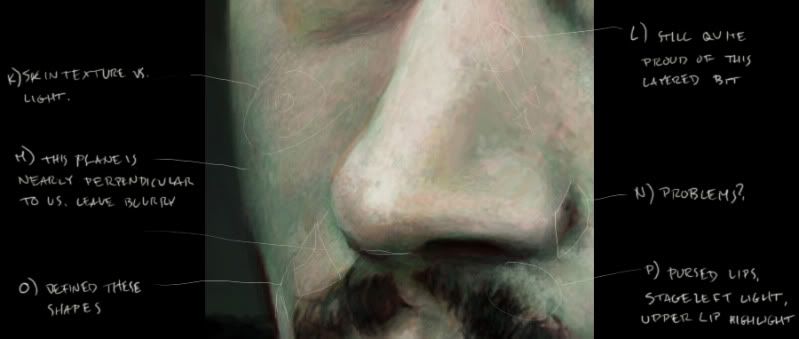
(K) When I was in second grade I twirled baton. I was staring at the gym floor one day and I noticed that where the light hit the floor, the scratches in the floor that were most perpendicular to the rays of light got lit up. That is, it made a circular pattern on the floor. Skin does a very similar thing. Except not scratchs, lumps.
(L) Yeah, I was really happy about that area of texturing.
(M) The front plane of Tom's face is kind of pinkish. You can probably see that. You can see a little of his right side down the side there in dark green. It's hard to draw things at that angle. I really have to work hard to remember to think of it as a nice round wall extending away from me. The texturing on this wall is minimal and distorted, blurred. Or it should be. I haven't quite succeeded yet.
(N) There are an awful lot of planes meeting up right here. It's tricky. Also I think there's a bit of scarring there on Tom. I've got to watch out for that, it makes the light catch in an odd way some times.
(O) A lot of what I do is find these tiny variations in value and color. This set of planes is varied in an attempt to show the rounded shape of his upper lip. His lips are pursed a little ( (P) muscle "orbicularis oris") so it's more round than usual. That last dark green section is quite important in definining that. It's the same effect as the side of his face. In fact, those planes are at a similar angle. Planes at similar angles will pick up light in a similar way. As long as there isn't another plane casting another shadow. I've messed that one up plenty.
This last picture isn't useful to try to explain in words right now. There's far too much going on that I can sort of reproduce, but not necessarily explain.
OH! It's that chin thing again! Except with fuzzies covering the part I was looking at before.

